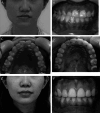Miniscrew implant applications in contemporary orthodontics
- PMID: 24581210
- PMCID: PMC11916351
- DOI: 10.1016/j.kjms.2013.11.002
Miniscrew implant applications in contemporary orthodontics
Abstract
The need for orthodontic treatment modalities that provide maximal anchorage control but with minimal patient compliance requirements has led to the development of implant-assisted orthodontics and dentofacial orthopedics. Skeletal anchorage with miniscrew implants has no patient compliance requirements and has been widely incorporated in orthodontic practice. Miniscrew implants are now routinely used as anchorage devices in orthodontic treatment. This review summarizes recent data regarding the interpretation of bone data (i.e., bone quantity and quality) obtained by preoperative diagnostic computed tomography (CT) or by cone-beam computed tomography (CBCT) prior to miniscrew implant placement. Such data are essential when selecting appropriate sites for miniscrew implant placement. Bone characteristics that are indications and contraindications for treatment with miniscrew implants are discussed. Additionally, bicortical orthodontic skeletal anchorage, risks associated with miniscrew implant failure, and miniscrew implants for nonsurgical correction of occlusal cant or vertical excess are reviewed. Finally, implant stability is compared between titanium alloy and stainless steel miniscrew implants.
Keywords: Miniscrew implants; Orthodontic anchorage; Risk factors.
Copyright © 2013. Published by Elsevier B.V.
Figures

Similar articles
-
Miniscrew implants as temporary anchorage devices in orthodontics: a comprehensive review.J Contemp Dent Pract. 2013 Sep 1;14(5):993-9. doi: 10.5005/jp-journals-10024-1439. J Contemp Dent Pract. 2013. PMID: 24685811 Review.
-
Comparison of stainless steel and titanium alloy orthodontic miniscrew implants: a mechanical and histologic analysis.Am J Orthod Dentofacial Orthop. 2014 Apr;145(4):496-504. doi: 10.1016/j.ajodo.2013.12.022. Am J Orthod Dentofacial Orthop. 2014. PMID: 24703288
-
Versatility of skeletal anchorage in orthodontics.World J Orthod. 2008 Fall;9(3):221-32. World J Orthod. 2008. PMID: 18834005 Review.
-
State of the art of miniscrew implants: an interview with Sebastian Baumgaertel. Interviewed by Robert P. Scholz.Am J Orthod Dentofacial Orthop. 2009 Aug;136(2):277-81. doi: 10.1016/j.ajodo.2009.02.015. Am J Orthod Dentofacial Orthop. 2009. PMID: 19651359
-
Three-dimensional finite element analysis of strength, stability, and stress distribution in orthodontic anchorage: a conical, self-drilling miniscrew implant system.Am J Orthod Dentofacial Orthop. 2012 Mar;141(3):327-336. doi: 10.1016/j.ajodo.2011.07.022. Am J Orthod Dentofacial Orthop. 2012. PMID: 22381493
Cited by
-
Medical and Dental Applications of Titania Nanoparticles: An Overview.Nanomaterials (Basel). 2022 Oct 19;12(20):3670. doi: 10.3390/nano12203670. Nanomaterials (Basel). 2022. PMID: 36296859 Free PMC article. Review.
-
Direct Anterior Tracks: Early and Functional Management of Class III Malocclusions-Case Report and Literature Review.Case Rep Dent. 2019 Jun 27;2019:9323969. doi: 10.1155/2019/9323969. eCollection 2019. Case Rep Dent. 2019. PMID: 31346478 Free PMC article.
-
Evaluation of stability of three different mini-implants, based on thread shape factor and numerical analysis of stress around mini-implants with different insertion angle, with relation to en-masse retraction force.Dental Press J Orthod. 2020 Nov-Dec;25(6):59-68. doi: 10.1590/2177-6709.25.6.059-068.oar. Dental Press J Orthod. 2020. PMID: 33503126 Free PMC article.
-
Relationship Between Laterality of Orthodontic Miniscrew Failure and Clinical Variables.J Clin Med. 2024 Nov 25;13(23):7115. doi: 10.3390/jcm13237115. J Clin Med. 2024. PMID: 39685574 Free PMC article.
-
Effect of Different Head Hole Position on the Rotational Resistance and Stability of Orthodontic Miniscrews: A Three-Dimensional Finite Element Study.Sensors (Basel). 2021 May 30;21(11):3798. doi: 10.3390/s21113798. Sensors (Basel). 2021. PMID: 34070904 Free PMC article.
References
-
- Vande Vannet B., Sabzevar M.M., Wehrbein H., Asscherickx K.. Osseointegration of miniscrews: a histomorphometric evaluation. Eur J Orthod. 2007; 29: 437–442. - PubMed
-
- Chen Y.J., Chang H.H., Lin H.Y., Lai E.H., Hung H.C., Yao C.C.. Stability of miniplates and miniscrews used for orthodontic anchorage: experience with 492 temporary anchorage devices. Clin Oral Implants Res. 2008; 19: 1188–1196. - PubMed
-
- Roberts W.E., Arbuckle G.R., Analoui M.. Rate of mesial translation of mandibular molars using implant‐anchored mechanics. Angle Orthod. 1996; 66: 331–338. - PubMed
-
- Chen Y.J., Chang H.H., Huang C.Y., Hung H.C., Lai E.H.H., Yao C.C.J.. A retrospective analysis of the failure rate of three different orthodontic skeletal anchorage systems. Clin Oral Implants Res. 2007; 18: 768–775. - PubMed
-
- Yu J.H., Lin Y.S., Chang W.J., Chang Y.Z., Lin C.L.. Mechanical effects of micro‐thread orthodontic mini‐screw design in relation to artificial cortical bone thickness. J Med Biol Eng. 2012, 10.5405/jmbe.1132 - DOI
Publication types
MeSH terms
Substances
LinkOut - more resources
Full Text Sources
Other Literature Sources
Medical

